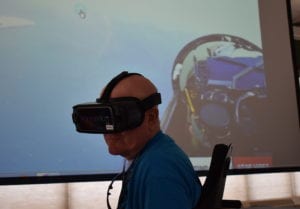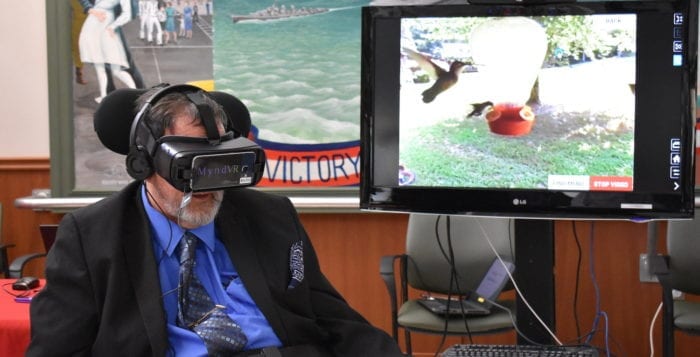It was something straight out of science fiction.
On May 2, the residents and patients at Long Island State Veterans Home on the Stony Brook University campus put on stubby virtual reality goggles and headphones. After just a few seconds, they were transported to another place entirely.

Vietnam veteran Al Anderson moved his head from side to side, up and down. He was no longer on Long Island but in Mozambique, Africa. To the left was a baby hippo and to the right grass plains of golden brown. One of the home’s recreational therapists spun Anderson around in his wheelchair, and then the VR changed, and he was suddenly in a suburban backyard where hummingbirds were feeding from a trough hanging above his head.
“It puts you right there, and if I had this available to me when I started to have some problems with [post-traumatic stress disorder], it would put me out of where I am to another place,” Anderson said. “If I woke up in the middle of the night, and I had this available to me, I could put it on and probably fall right back asleep without having a problem.”
Residents and patients of the veterans home were able to try one of the new 10 MyndVR devices now part of the home’s recreational therapy tools. MyndVR is a company based out of Dallas, Texas, that tries to provide VR technology to the elderly in retirement communities and home health care services. Directors at the home hope this will become a part of regular therapy.
“It’s not just a video game, it’s actually very therapeutic,” said Michelle Cheslak, the director of therapeutic recreation. “It stimulates their cognitive ability to recall a memory. Maybe it unlocks a memory of Paris, maybe a honeymoon that they’re now reliving. Think about it. They’re probably not going to be able to go to Paris ever again, now they can travel wherever they want, right from their seat.”
“It stimulates their cognitive ability to recall a memory. Maybe it unlocks a memory of Paris, maybe a honeymoon that they’re now reliving.”
— Michelle Cheslak
The VR headset allows those who wear it to experience full sensual awareness as the headset tracks head movement and changes audio direction based on where the person is facing.
Deputy Executive Director of the Long Island State Veterans Home Jonathan Spier said that the veterans home is the first in the country to use VR for therapy.
“My goal is to really try to use this with my veterans who suffer from depression, anxiety and PTSD,” Spier said. “Some [residents] are just too physically disabled to go out into the community, so this is some technology to let that veteran go anywhere in the world.”
The money for the VR headsets was provided through a grant from the non-profit Bowlers to Veterans Link, an organization made up of bowlers and bowling alley owners who raise money for veteran causes.
“For the people who do the work, and try and heal the veterans, [local veteran centers] are the most appreciative of the value from that,” said John Laspina, the chair of the BVL board of directors and president of Maple Family Centers.
Some of the different VR experiences include NASCAR racing, a tour through Paris, taking off in a fighter jet and swimming with dolphins among several others. Though the devices are not physically intensive, Spier said people with epilepsy or other seizure disorders will not be able to use the devices.
“Some [residents] are just too physically disabled to go out into the community, so this is some technology to let that veteran go anywhere in the world.”
— Jonathan Spier
“It’s like I’m there, either taking off and landing,” said Vietnam veteran and adult day health care patient James Saladino about the fighter jet experience.
Veteran Ronald Kelson served in England from 1954 to 1956. He never got to visit Paris, but with virtual reality, he was able to get a small tour.
“I saw all of London, but I didn’t get to see all of Europe,” Kelson said. “You feel like you’re part of it.”
Executive Director Fred Sganga said he wants technology like this to help remove the stigma that nursing homes are depressing, monotonous places.
“We’re thrilled to be cutting edge,” Sganga said. “A nursing home should not be a boring place. I have an obligation to provide my residents with an outstanding quality of life. We like to say our residents have better social lives than we do.”
Cheslak said that as younger veterans arrive at the veterans home, there is a growing desire and need for more technologically-based therapy.
“We’re getting more younger veterans coming in who are computer savvy,” Cheslak said. “They have iPhones and iPads, and they’re looking for that new technology, for that action. People in their 60s and 70s want to go scuba diving again, they want a thrill.”





